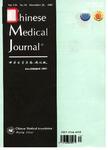The influence of admission glucose on epicardial and microvascular flow after primary angioplasty
The influence of admission glucose on epicardial and microvascular flow after primary angioplasty作者机构:Department of Cardiology Beijing Friendship Hospital Beijing 100050 China
出 版 物:《Chinese Medical Journal》 (中华医学杂志(英文版))
年 卷 期:2006年第119卷第2期
页 面:95-102页
核心收录:
学科分类:1002[医学-临床医学] 100201[医学-内科学(含:心血管病、血液病、呼吸系病、消化系病、内分泌与代谢病、肾病、风湿病、传染病)] 10[医学]
主 题:myocardial infarction glucose percutaneous transluminal coronary angioplasty
摘 要:Background Patients with elevated admission glucose levels may be at increased risk of death after myocardial infarction, independent of other baseline risk factors and more severe coronary artery disease. However, data regarding admission glucose and epicardial and microvascular flow after primary angioplasty is limited. Methods Angioplasty was performed in 308 ST-segment elevated myocardial infarction patients. Patients were divided into 3 groups on the basis of admission glucose level: group 1, 〈7.8 mmol/L; group 2, (7.8 - 11.0) mmol/L; and group 3, ≥ 11.0 mmol/L. Results Compared with group 1, patients in group 2 and group 3 were more often female and older. Triglycerides (TG) in group 3 were significantly higher than group 1. At angiography, they more frequently had 2-vessel or 3-vessel disease. In the infarct-related artery, there was no relationship between hyperglycemia and thrombolysis in myocardial infarction (TIMI) 3 flow after percutaneous coronary intervention (PCI) (89.7%, 86.0% and 86.3%, P=NS). However, corrected TIMI frame count (CTFC) in group 2 and group 3 were more than group 1. TIMI myocardial perfusion grade (TMPG) 0-1 grade among patients with hyperglycemia after PCI were more frequent (30.9% and 29.0% vs 17.3%, P〈0.05). There was less frequent complete ST-segment resolution (STR) and early T wave inversion among patients with hyperglycemia after PCI. Conclusion Elevated admission glucose levels in ST-segment elevation myocardial infarction patients treated with primary PCI are independently associated with impaired microvascular flow. Abnormal microvascular flow may contribute at least in part to the poor outcomes observed in patients with elevated admission glucose.



